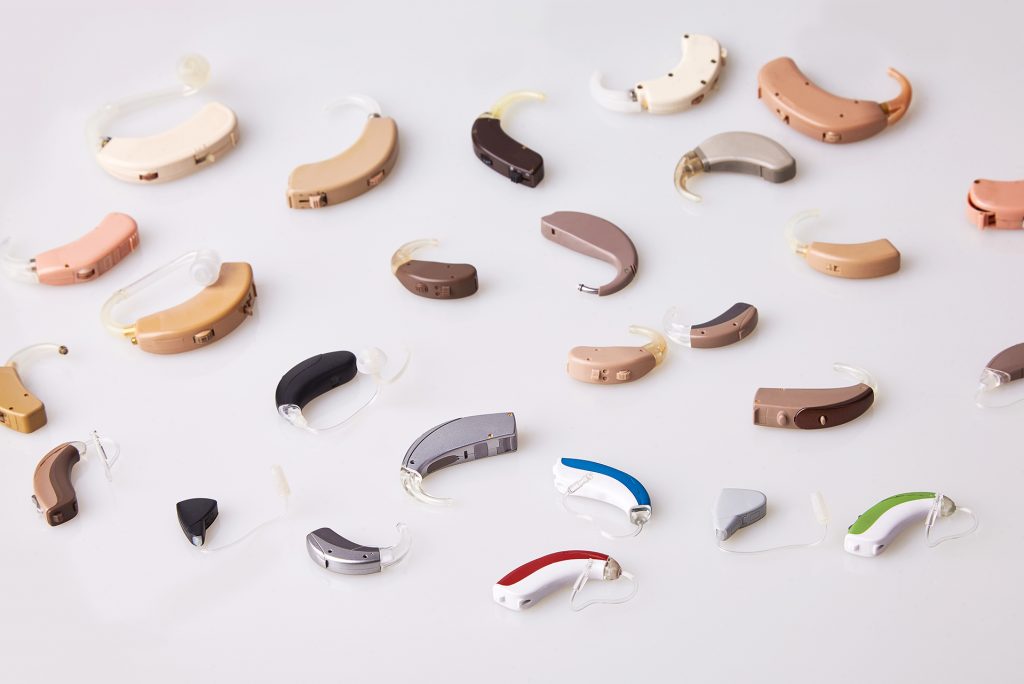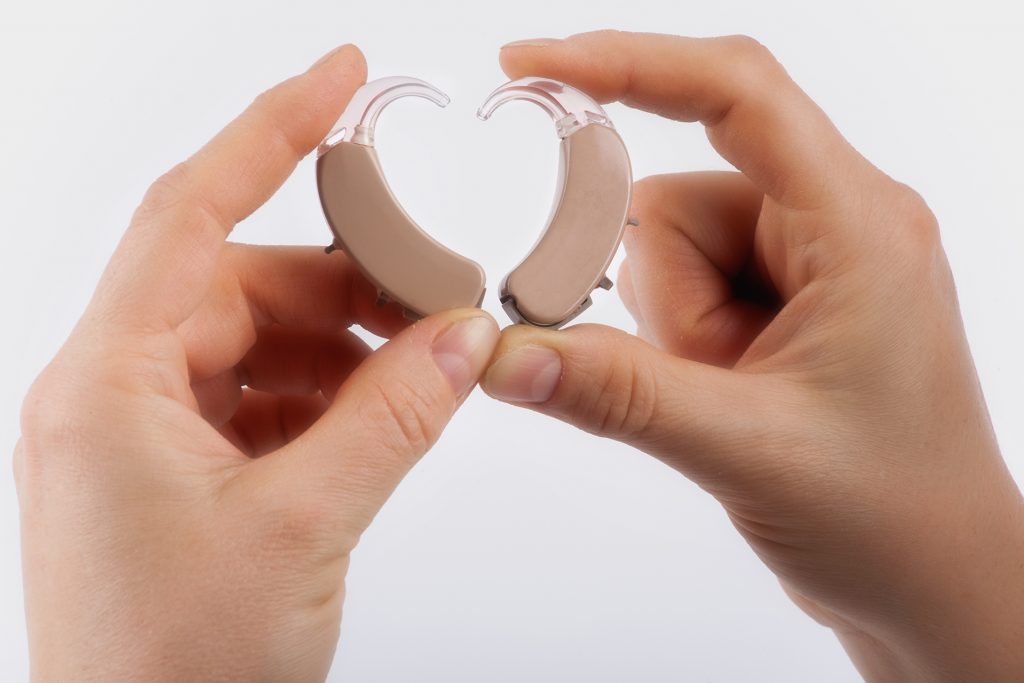The different kinds of hearing aids explained

For most people hearing loss is simply a part of life that should be expected and accepted, but in the more extreme cases it becomes a far more daunting prospect. While profound hearing loss will no doubt have a huge effect on your daily life there are ways to mitigate its severity, and boost your hearing back to comfortable levels. We are of course talking about hearing aids.
However, even with the knowledge that your hearing can be rescued many people still struggle with knowing exactly which hearing aid might be right for them, and it’s not hard to see why. There are many makes, models, shapes and sizes to choose from and as each variation has its own positives and negatives, it can be a little overwhelming to decide which is best for you.
At Nathan Gluck Hearing Care we pride ourselves on putting the patient first, in all aspects of our hearing care. This means making sure that you are as happy with your hearing aid choice as can be, and getting you well on the way to enjoying the beauty of sound all over again.
Read more: The History Of Modern Hearing Aids
The different kinds of hearing aid
There are so many classes of hearing aid that even before you decide which brand you want to use, you must first decide which type of hearing aid is best for you based on how you wear it, and how they generally perform. To make this decision a little easier for you, let’s break down the different kinds of hearing aids out there, and hopefully find the one that’s best for you!
BTE – Behind The Ear

By far and away the most common form of hearing aid, the Behind The Ear (BTE) unit is one of the most flexible platforms in terms of its function, and who it is designed for. A BTE unit consists of a receiver unit that sits (you guessed it) behind the ear. This is where sound is captured, amplified and exported through a speaker.
Once the sound has been generated it passes through an airtube system that is inserted into the ear canal, transferring sound from the speaker behind the ear directly into the ear canal. This means that the BTE system offers very little occlusion, meaning that the user does not feel so “plugged up” by the hearing aid.
There are other reasons that the BTE system of hearing aids have become so popular, and they are largely related to the fact that running the brains of the unit outside of the ear gives much more freedom in terms of size, shape and carrying capacity. One of these reasons, and one that has helped to move hearing aids into the modern world is the now widespread inclusion of rechargeable batteries.
Smaller units still rely on using non-rechargeable button cell batteries that must be changed every 3-20 days in order to keep the hearing aids working. The problem with this is twofold; the cost of buying huge amounts of batteries and remembering to change them. Many users of legacy hearing aids complain that sometimes they simply forget to change their batteries and are left disadvantaged in the world surrounding them.
With modern BTE hearing aids this is less of a problem, as adding putting your hearing aids on to charge to your nightly routine is as simple as brushing your teeth. Should you find yourself out and about for longer than expected, a lot of modern units now take advantage of the bounds made in headphone technology, and have wireless charging cases that can hold several full charges for your hearing aid, allowing you to go on and on using them without having the dreaded power outage of years gone by.
Another great advantage of BTE hearing aids is how easy they are to use, being larger and less fiddly than their more discrete counterparts. In the past this has lead to more onboard controls like mode buttons and volume dials, but in the last few years has also meant that inter-device connectivity can be installed in place of physical controls. These new features allow most modern BTE devices to connect to smartphones, and be controlled quickly and easily from the device in your pocket. This connectivity also means that your hearing aids can double as headphones, meaning you no longer have to crank the volume up past eleven just to hear your favourite songs.
With all these positives there is of course one glaring negative, if you see it as so. As with all things in life there is a trade-off, and the BTE units are no exception. Hearing loss can be a sensitive subject for many, and so the idea of having a hearing aid on show could dissuade many from wearing one. Hearing aid manufacturers do their best to mitigate this though by offering their units in a wide range of tones to best match your skin, or in bright colours to let you make your hearing a statement.
RIC / RITE – Receiver In Canal / Receiver In The Ear

Receiver in the ear and in canal systems are very similar to BTE hearing aids, but they do away with using an airtube system and instead use a speaker attached by a short wire over the ear. With the speaker now on a remote wire it can be placed directly in the ear canal allowing sound to be transmitted straight to the user.
The pros and cons of the RIC / RITE systems are very similar to their BTE cousin’s, but with the slight caveats brought through moving the speaker inside the wearer’s ear. For cons, the speaker being inside the ear canal makes it susceptible to moisture and clogging with earwax, meaning that the unit might take a little more maintenance than a standard BTE.
The trade off for this is increased discretion, as the behind the ear module is smaller due to the speaker being displaced to the ear. For those users who may feel somewhat self-conscious about their hearing these units find a good balance between advanced technology, and discreet usability.
ITE – In The Ear

Continuing the trend of moving from behind the ear to in front of it, we arrive at In The Ear (ITE) hearing aids. As BTE aids have become smaller and more advanced, the decline of the ITE unit has been significant, but there are still some for whom an ITE unit will be the most beneficial.
ITE units are somewhat larger than most other hearing aid types, which makes them suitable for users who may suffer from having a lower level of dexterity and would struggle with smaller and more fiddly units. These units often use large cell batteries and have the best runtime of the in ear devices, often have onboard controls and even directional microphones to make your hearing as good as can be.
The downsides to the ITE units are obvious, in that they are… obvious. Discretion is hardly the word that first jumps to mind when discussing ITE hearing aids, and they also carry the connotation of being an older piece of technology due to their bulky style. This can lead to many people being put off these units, but for those who need the heightened dexterity they are a perfect fit.
ITC – In The Canal

As we come to the closing stages of our list of hearing aids, they become more and more focussed on being well hidden within the ear, bringing us to the In The Canal (ITC) hearing aids. An ITC unit consists of the same technology found in the ITE hearing aids, but scaled down to fit more snugly within the ear.
These ITC aids find a comfortable balance of features versus compact size, with the button cell batteries still providing a reasonable amount of runtime and the size of the hearing aid being able to house controls like mode switches and volume wheels, as well as directional microphones in some cases. The inevitable trade off for these hearing aids however is that due to their being physically inside the ear canal they are vulnerable to damage from moisture and earwax, and do have the effect of leaving the user feeling blocked up and occluded. Many feel that this is a small trade off for the advantages gained in terms of keeping the hearing aid out of sight and out of mind.
IIC / CIC – Invisible In Canal / Completely In Canal
Our final stop in the different types of hearing aids lands with Invisible/Completely In Canal (IIC / CIC) systems. These hearing aids offer their users the most discretion but at a loss of function. Due to their small size IIC hearing aids do not have the power that will be required by some hearing loss sufferers.
This makes these smaller units more suitable for those with only mild hearing loss, who may be conscious of keeping their hearing loss under wraps. The improved discretion also amplifies the negatives felt in ITC hearing aids, resulting in a greater sensitivity to moisture and earwax blockage. The smaller frame also means that there is less surface area to mount external controls so these units don’t normally have the same level of “on the fly” adjustability as other systems.
There are however functional advantages unique to IIC and CIC hearing aids, in that their concealed location deep within the ear means that the sound quality they transmit is excellent, and very well protected from wind noise.
So which hearing aid do I need?
Now that we have taken you through what all the different hearing aid types are, its is up to you to get an idea of which system will match with your needs both from a functionality and a lifestyle perspective.
With this understanding in mind, you should then come and see a specialist Audiologist for a hearing aid consultation. They will be able to tell you the exact condition of your hearing, and which class of hearing aid will be best for you. This conversation will be much simpler, and far less daunting if you can also understand why they are choosing the system they are.
Nathan Gluck Hearing Care are a proudly independent audiology practice operating in and around the North London area and we put the patient experience first. This means that when you come to see us for a hearing aid consultation, we won’t rest until your hearing is back to full strength, and you feel confident and comfortable in the hearing aids we choose for you.
Our idependence allows us to choose your hearing aids from all of the large manufacturers like Oticon, Phonak and many others, without any bias or ulterior motive
Get in touch with us today to book your hearing consultation either in our North London clinics, or for a home visit in the N, NE, HA, EN and WD postcodes
Get in touch
If you’re concerned you may have a problem with your hearing, or you’d like to arrange a hearing test for a family member, we’re here to help.
Nathan Gluck Hearing Care,
20 Wentworth Road,
Golders Green, London,
NW11 0RP, UK